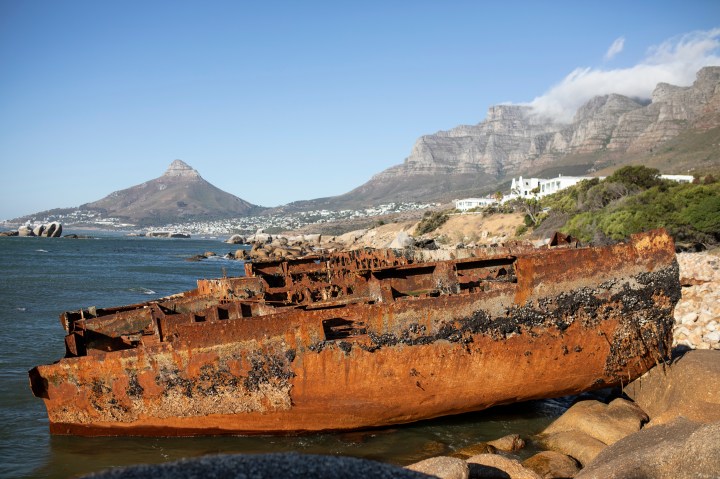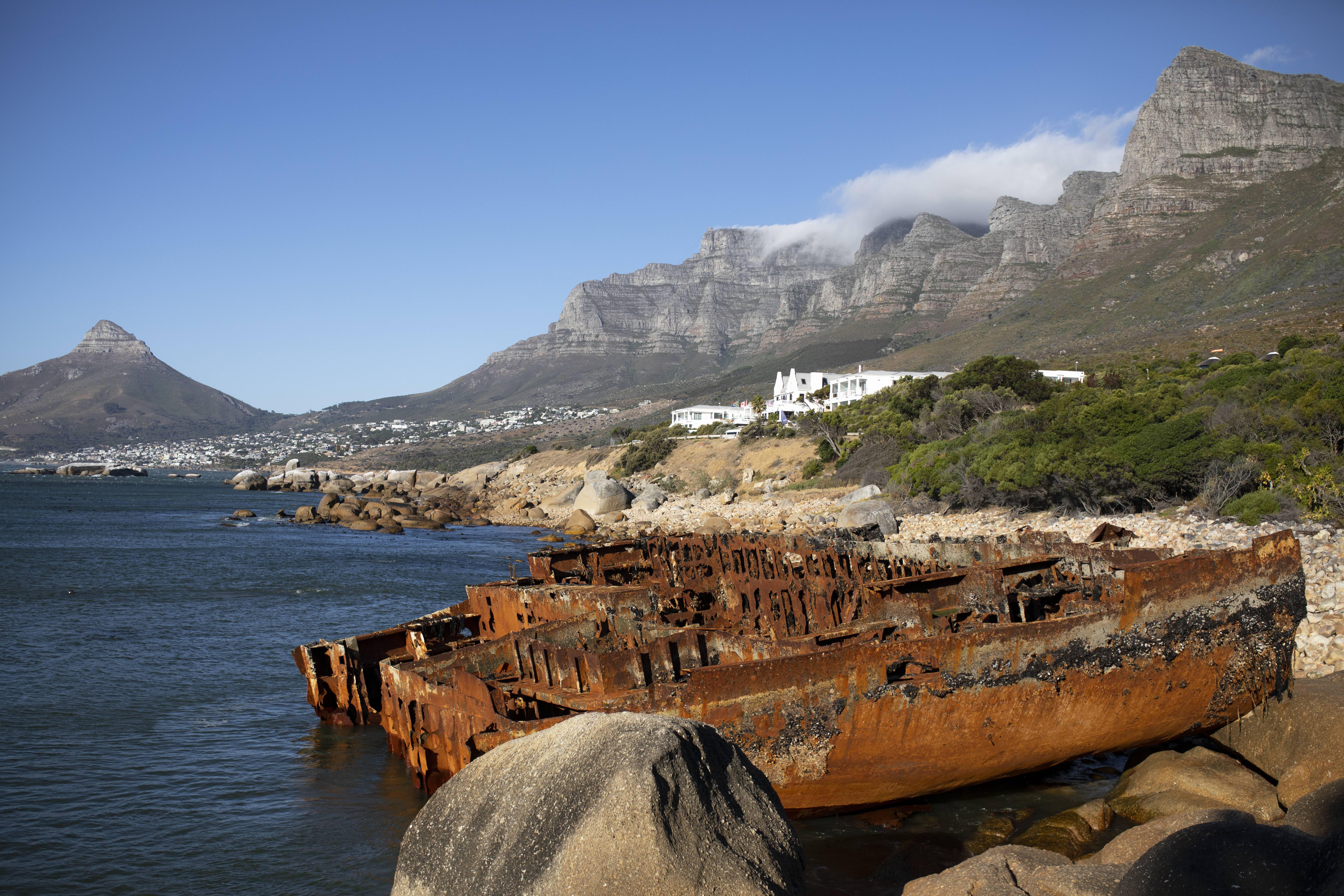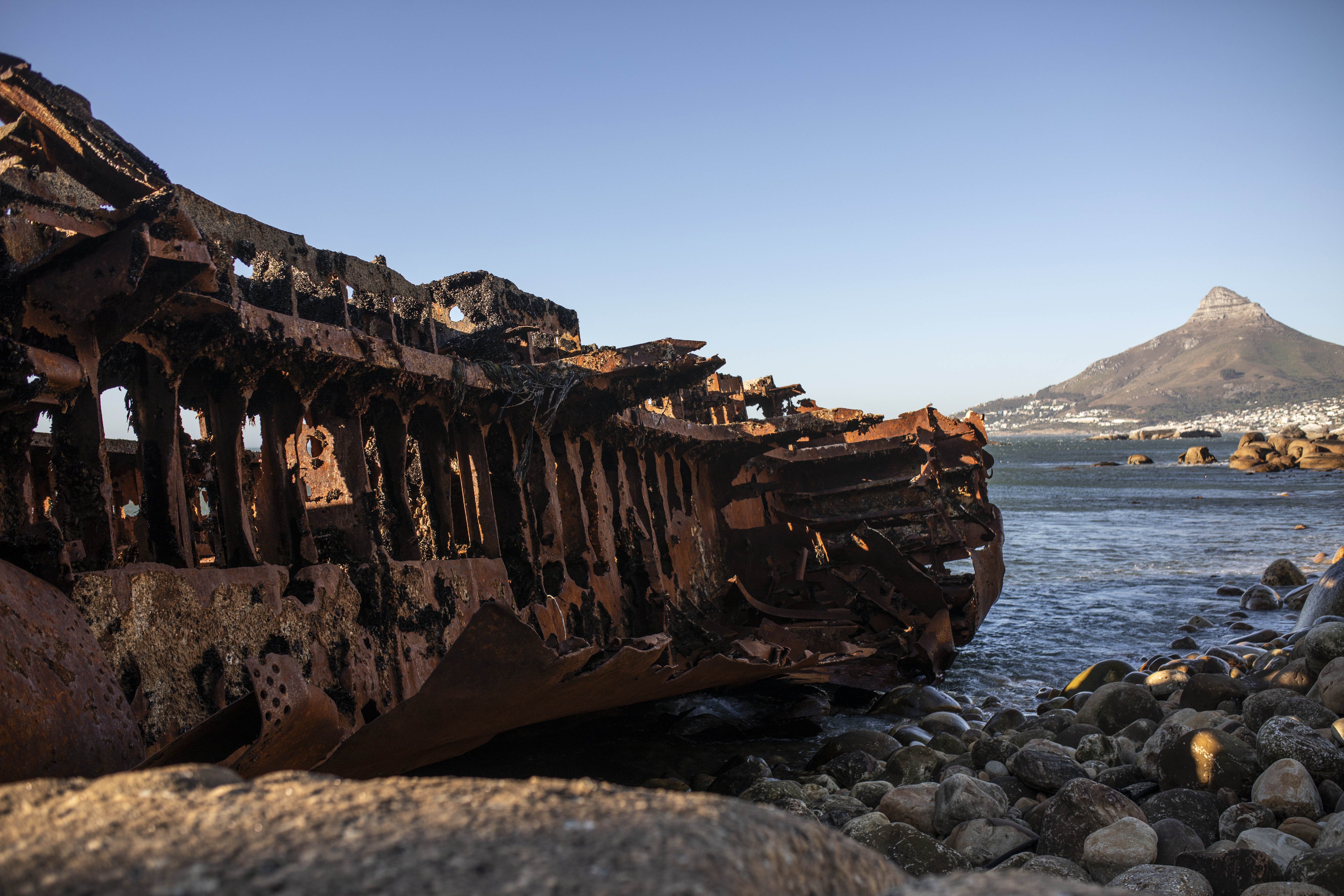UP FROM THE DEPTHS
The Antipolis wreck: Ship’s memories resurface from the deep during exceptional summer storm

The ocean has resurrected the ‘Antipolis’ from a watery grave, recalling the night when it and a companion vessel joined the hundreds that have floundered at the Cape of Storms.
It was a dark and stormy night. The ocean was heaving with huge swells and the wind was gale force from the northwest. Two deserted ships were adrift, relentlessly pushed towards shore by gusts of up to 55 knots from across the southern Atlantic. Braving the rain and cold, scores of Capetonians stood in a car park off the coastal road between Camps Bay and Llandudno, transfixed as the 42,050-tonne tanker Antipolis wallowed unerringly towards the rocky shoreline at Oudekraal in the fading light. An almost-full moon rose behind dark clouds, lifting the tide. Some two kilometres to the south, the 32,913-tonne tanker Romelia would hours later suffer the same fate, foundering on Sunset Rocks at Llandudno at 1.30am.
Like the spectators in the car park, Captain T Hara of the 9,200hp Japanese tug Kiyo Maru No 2, who had spent two months laboriously towing the two empty tankers down the west coast of Africa from Greece, en route to scrapyards in Taiwan, could only look on. As the Cape of Storms lived up to its name, the towing cables had snapped less than half an hour before sunset on 28 July, 1977. Efforts to reconnect them in rolling 10m swells had come to nought.

Th Antipolis. (Photo: Brian Ingpen)
He “could do nothing”, he later told a journalist from The Argus, which, like the Cape Times, splashed the wrecks across their front pages of 29 July 1977.
Now, 44 years later, the unusual summer storm of Wednesday 19 January, which SA Weather Service marine senior scientist Dr Tamaryn Morris has called a one-in-20-year event, has thrown part of the sunken Antipolis back up on the rocks.
It is unclear how this summer storm managed to do what decades of winter storms did not.
Morris offered little insight other than saying that waves of the combined height and period on that Wednesday have only occurred in the summer once in the past 19 years. But waves of similar, if not greater, power are relatively common in winter. Swell guru and founder of popular surfing website Wavescape, Steve Pike seemed to offer the best explanation. That Wednesday’s swell was from a more westerly direction than most winter swells, said Pike, and, it being summer, there might have been less sand covering the wreck of the Antipolis. This, combined with the wreck having rusted and being broken apart by waves over the decades and, so being lighter, probably resulted in a large section of the Antipolis being tossed back on to shore.
Unlike the Romelia, which hit a rocky shelf 800m offshore and broke in two the next day, the bow of the Antipolis came to rest on a semi-protected rocky beach just 75m from the road, almost as if she had been docked there.
Llewellyn Raubenheimer, reporting in the Cape Times on Friday 29 July 1977, quoted Bakoven resident Kevin Robb, who was among those who watched the Antipolis run aground at 7.45 the previous evening: “It came in gently and just settled down.
“She didn’t seem to move an inch after that, almost as if she’d been deliberately moored there.”
The Argus reporters — unnamed — wrote that a broken chain and shredded ropes were “draped from her bows”, and “if the weather improves an agile person could scale ropes dangling from the Antipolis” to board the ship.
By Saturday 30 July, the Weekend Argus reported a policeman with a guard dog had been assigned to “prevent people taking souvenirs”. By this stage there was a gangplank and a rope ladder dangling off the port side.
The Argus reporter Henrie Geyser and photographer Robin Brown were the first press group to board the ship. Geyser’s report on 3 August noted “a hasty looters’ trail visible throughout the ship”.
The “beautiful bar” in the stateroom adjoining the captain’s cabin had glasses and “still a bottle of gin”, there were crockery and pots lined up in the galley and linen in the cupboards, but the barometer, gyrocompass, radio and medical equipment had been stolen. Doors and glass had been smashed, drawers pulled out and their contents overturned. The newly revived wreck has attracted its share of onlookers. During an hour photographing the now rusted hulk, amateur vlogger Adam Spires and a friend, and another couple, clambered down the path from the car park and took photos.
The City of Cape Town has urged people not to clamber onto the wreck, but the scene today is a far cry from the thousands who flocked to see the wreck in its first days.

The remains of the wrecked Antipolis Ship on January 25, 2022 in Cape Town, South Africa. (Photo by Gallo Images/Daily Maverick/Leila Dougan)
The Argus reported that on the first weekend cars were parked along the shoulder of the coastal road for “more than a kilometre either side of the grounded vessel”. Traffic police begged people to stay away.
“You can tell people they need not rush here,” a “harassed” traffic officer told The Argus reporters. “She’ll be here for months.”
“Checking the wreck is a thing” was the headline to Shauna Westcott’s story in the Weekend Argus on Saturday 30 July. Westcott said ice-cream sellers were doing a roaring trade despite the cold weather, including the quip: “a lolly makes you jolly”.
“A carnival atmosphere broke out when a yellow helicopter came into view. As it hovered above the deck of the Antipolis, a woman screamed ‘For God’s sake man, Bertie, pass me the binoculars’.”
The ship was so stable onshore that parties were held on the deck in the few years before authorities ordered the ship cut to the waterline, after which it became a popular dive site.
South African History Online states it “used to be a venue for parties until its superstructure was removed and sold as scrap”.
Comments on photo-sharing site Flickr suggest these were well-organised parties, although at the height of apartheid they were probably for white people only.
Vivien Bruwer wrote that Andre Dumas from Wood Pecker Promotions organised a shipwreck party on board. It was “amazing”, she wrote, with disco equipment and “everything one required to have a good party” taken on board via specially built scaffolding.
Bruce Frykman wrote that he was on a business trip from the US in 1977 and attended a party hosted onboard the Antipolis by the National Sea Rescue Institute, with all the beer and wine you could drink.
“We danced to rock and roll on the ship’s bow and later my wife and I climbed the open stubby steel bars welded to the main mast all the way up to the crow’s nest. There we shared a bottle of wine while looking down at the dancers far below,” he said.
NSRI spokesperson Craig Lambinon this week expressed doubt that the NSRI would have hosted a party on board a wreck, but a photo shared by Cape Times shipping writer Brian Ingpen suggests otherwise. Graffiti on the superstructure has the words “NSRI Station 8 Hout Bay” and “community carnival — Maynardville”. A photo on Flickr, presumably shot earlier, has just the words “Watney’s Grill”, the name of a restaurant in Sea Point. The various graffiti points to fun having been had, and possible party sponsors.
Tony Jackman, who now writes for Daily Maverick but started his career as a Cape Times shipping reporter, under legendary shipping editor George Young, said he had vague memories of parties aboard the Antipolis being mentioned, but he had never attended one.
Jackman was 23 and working under Young when the two ships came to grief. He recalled that Young, who lived in Camps Bay, would pick him up at Three Anchor Bay on the way to work. That Thursday morning, 28 July 1977, Young told him to look out to sea towards Robben Island. He pointed out two tankers, one behind the other, and a tiny tug in front of them. With huge seas running, Jackson said Young predicted the tankers would come adrift. Young wrote as much in his column, published on the 29th, with photos of the wrecks on the front page.

The remains of the wrecked Antipolis Ship on January 25, 2022 in Cape Town, South Africa. (Photo by Gallo Images/Daily Maverick/Leila Dougan)
Young wrote that the tugboat Kiyo Maru No 2 had sought to come into port to refuel and replenish supplies, which would have meant port tugs having to take over the tankers’ tow line and look after them at sea “for at least four days”.
But the port tugs were “too fully committed to dock movements and are in any case no match for handling the high-sided tankers secured to each other in time of winter storms”, wrote Young.
The Japanese tug would have had to wait for Safmarine’s 18,000hp world-class tug Wolraad Woltemade “to assume responsibility off the coast for the two tankers”. At the time, the Wolraad Woltemade was trying to get the 306-tonne Taiwanese trawler Kuoai and its 100-tonne cargo of frozen fish off the beach where it had run aground, metres from threatening dolosse outside the Cape Town harbour. Captain T Hara was turned back with his tankers to wait out the storm on the open ocean.
Hara said he believed the 56mm-diameter cables linking his tiny 252-tonne tug to the towed ships had snagged on yet another wreck, on the seabed. Interviewed by Sean O’Conner of The Argus, Hara said his tug was not in deep water and the 720m cable to the Antipolis was “well below the surface”. It must have snagged and broken under strain.
Hara said the break in the cable showed it “had caught on something” and he had seen “a shine” below the surface of the water. The cable to the Romelia “snapped in exactly the same way”.
His cargo joined the more than 350 other wrecks along the Peninsula shoreline, making Young’s observations prescient. Young, however, was wrong in one respect. He predicted the grounded Antipolis would soon list and break up. But, washed up on granite, it stood rock steady for years.
This time around, though, after 44 years in the unforgiving ocean, it is in no state to host a party. DM168
This story first appeared in our weekly Daily Maverick 168 newspaper which is available for R25 at Pick n Pay, Exclusive Books and airport bookstores. For your nearest stockist, please click here.

[hearken id=”daily-maverick/9041″]

















 Become an Insider
Become an Insider
While recalling the event to friends at a Superbowl party, I did a quick google search and found your article to lend credence to our doubting friends. -Thanks